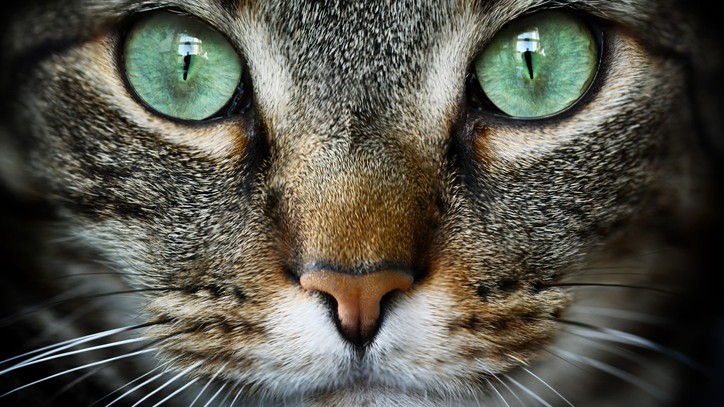Why are my cat's eyes watering?
A cat’s eyes watering is not normal and can indicate a painful eye condition. Don’t miss the signs!

When a cat’s eyes are watering, this is medically known as ‘epiphora’. Epiphora is a symptom of many conditions, rather than a disease. In a normal cat, tears are constantly produced in order to protect and lubricate the surface of the eye. They usually drain away through little holes in the corners of the eyelids. If the tears are overspilling down the face, this can signal either an overproduction of tears or a problem with drainage. A thick (mucous) discharge can also signal a problem. Eyes are very delicate structures, so you should never ignore weepy eyes. See your vet as soon as possible.
What symptoms are seen with watery eyes in cats?
The symptoms of eye problems will vary depending on the cause. Whilst watery eyes is a symptom, you may also notice:
- Excessive tears
- Pink staining on the fur under the eyes, caused by excess tears flowing down the face
- Green or gunky discharge from the eyes
- Bloodshot eyes
- Blinking more or squinting
- Holding the eye closed
- The third eyelid across the eye
- Cloudy eyes
- Rubbing the eyes with a paw or on the furniture
If you notice any of these symptoms, it’s time to book an appointment with your vet!
Read more:
What causes watery eyes in cats?
Blocked tear ducts will cause the tears to overspill and flow down the face. This can happen in several conditions. For example in sinusitis, where the sinuses become inflamed and swollen, pressing on the duct. Epiphora is common in flat-faced breeds, since the shape of their face interferes with the tear duct.
Eye infections, or conjunctivitis, commonly cause watery eyes in cats. Conjunctivitis (inflammation of the conjunctiva) means the membrane covering the inside of the eyelids and the whites of the eye becomes red and swollen. This can be caused by bacteria or viruses.
Trauma to the eye, or a foreign body stuck in the eye, can also cause watering. Grass seeds or similar can easily become lodged underneath the eyelids. Sometimes eyelashes grow in the wrong place, on the inside of the eyelids, and act like a foreign body causing damage and infection. Foreign bodies are painful, so symptoms of pain would be seen alongside the watering.
Get the best advice, tips and top tech for your beloved Pets
An ulcer on the surface of the eye (a corneal ulcer) will cause watery eyes alongside pain, excessive blinking, redness and sometimes cloudiness. Corneal ulcers can be caused by trauma or infection.
Cat flu, caused by feline calicivirus or herpesvirus, is another common cause of watery eyes in cats. Sometimes watery eyes are the only symptom, but more often this is accompanied by sneezing and a discharge from the nose. Cats may also have a high temperature, become lethargic and go off their food.
Especially in the summer months, watery eyes in cats can be caused by allergies. This can be allergies to pollen, dust mites or food, amongst other things. Cats with allergies often have ongoing skin problems too, including excessive itchiness.
Read more:

How do you treat watery eyes in cats?
Before starting treatment, your vet will need to make a diagnosis. They will start by performing a physical exam. This may include looking at the skin and mouth, as well as the eyes. They may need to put local anaesthetic drops in the eye to make the exam more comfortable. Coloured drops called fluorescein are often used to show up any damage or ulcers on the surface of the eye. They may also need to take swabs, to look for infection. Following this, further investigations may be needed, depending on the case.
The treatment will very much depend on the cause. Sometimes no treatment will be given, for example with epiphora in flat faced breeds. However, a management plan would be put in place, to prevent the excess tears causing a skin infection due to the ongoing moisture.
Bacterial infections can be treated with antibiotic drops into the eye. Viral infections can be a bit harder to treat. Antiviral medications are available in some circumstances, while other times it may be best to let the virus run its course. Only a vet can decide this!
There are various treatments used for eye ulcers, depending on the severity. These range from pain relief and antibiotic drops to bandage contact lenses and surgery. Your cat may need a sedation or anaesthetic to assess the eye and remove any foreign bodies.
If your cat has chronic (ongoing) watery eyes, it’s important to keep the skin on their face as clean and dry as possible, to prevent bacterial skin infections. Talk to your vet about how to manage your cat’s ongoing watery eyes.
Final thoughts
If your cat’s eyes are watering, producing a mucous discharge, or appear red and sore, it’s important to book a check-up with their vet as soon as possible. Eye conditions can not only be painful, but they can also deteriorate rapidly and lead to permanent damage, including blindness. With eyes, it’s always better to be safe than sorry!
Sarah-Jane Molier graduated in 2009 and has been enjoying life as a vet ever since. She currently works as Head Veterinarian in a small animal practice. Sarah-Jane particular enjoys internal medicine, alongside her managerial role. When not working in practice Sarah-Jane enjoys sharing her knowledge and helping pet parents by writing on a wide variety of animal health and medicine topics. In her spare time Sarah-Jane loves walking Nero (her rescue dog), gardening with her two young children and reading.

